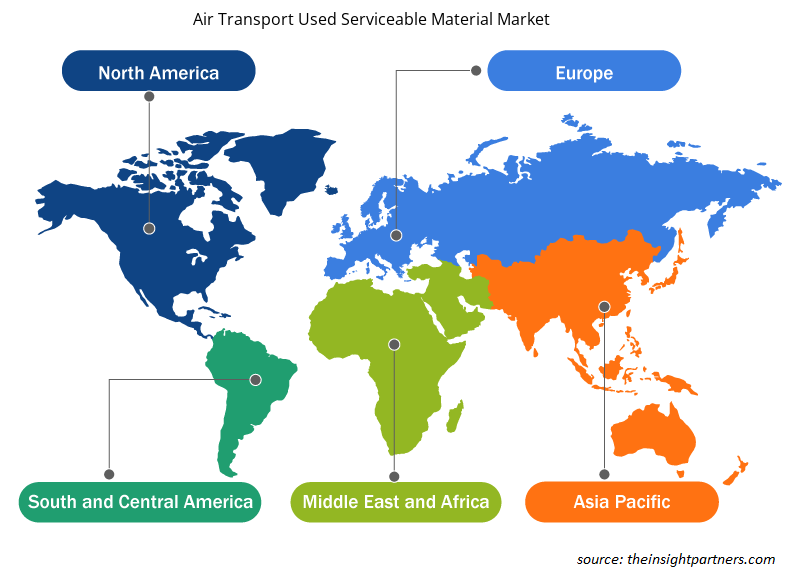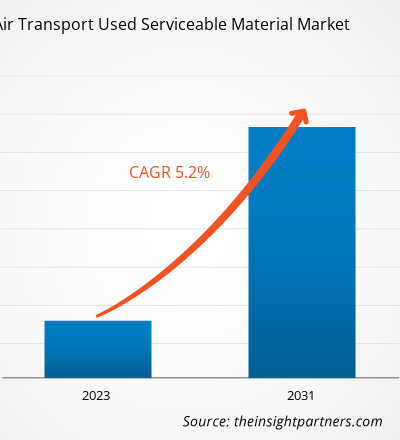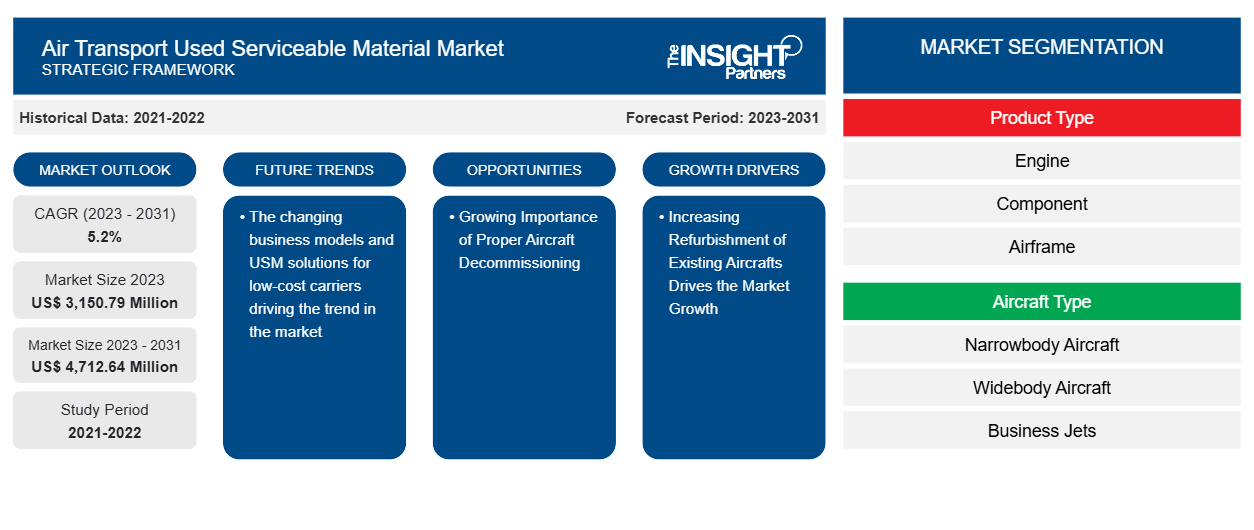Der Markt für gebrauchte Wartungsmaterialien für den Lufttransport soll von 3.150,79 Millionen US-Dollar im Jahr 2023 auf 4.712,64 Millionen US-Dollar im Jahr 2031 anwachsen. Der Markt soll zwischen 2023 und 2031 eine durchschnittliche jährliche Wachstumsrate (CAGR) von 5,2 % verzeichnen. Die sich ändernden Geschäftsmodelle und USM-Lösungen für Billigflieger treiben den Trend auf dem Markt voran. Die Betriebsabläufe und Geschäftsmodelle von MRO-Unternehmen ändern sich schnell, was wiederum von Faktoren wie dem harten Wettbewerb und der sich ständig ändernden globalen Dynamik getrieben wird. Der sich verschärfende Wettbewerb zwischen Unternehmen in Verbindung mit sich entwickelnden Flugzeugflotten und neuen Marktteilnehmern in der Luftfahrtbranche hat die Nachhaltigkeit der MRO-Unternehmen bedroht und die Akteure dazu veranlasst, nach innovativen Geschäftsmodellen zu suchen.
Marktanalyse für gebrauchte Gebrauchsmaterialien im Lufttransport
Die Luftfahrtindustrie erlebt ständig mehrere bedeutende Veränderungen in Bezug auf Fertigungstechnologie, MRO-Technologie und Trends bei der Flugzeugbeschaffung. Zivile Fluggesellschaften, Eigentümer von Geschäftsflugzeugen und regionale Fluggesellschaften profitieren massiv vom Rückgang der Kosten für Flugturbinentreibstoff in den letzten Jahren. Auf der anderen Seite legen Triebwerkshersteller großen Wert auf die Produktion von Flugzeugtriebwerken mit längerer Lebensdauer und profitieren davon. Die längere Lebensdauer von Flugzeugtriebwerken führt zu einer Verknappung der Aftermarket-Lieferkette in der Triebwerksindustrie. In ähnlicher Weise ermöglicht der Rückgang der Kosten für Flugturbinentreibstoff den Flugzeugeigentümern, ihre bestehende Flotte länger zu halten, was zu kürzeren Abbruchzeiten für Flugzeuge führt. Diese beiden Faktoren wirken sich positiv auf das Wachstum des Luftverkehrs unter Verwendung von gebrauchsfähigen Materialien aus.
Marktübersicht für gebrauchte und gebrauchsfähige Materialien im Lufttransport
Bei Serviceausfällen einiger wichtiger Flugzeugkomponenten wird in allen vier Flugzeugtypen USM (Air Transport Serviceable Material) verwendet . USM verkürzt die Installationszeit des Produkts und verringert die Kosten. In der Luft werden USMs verwendet, die hauptsächlich in Schmalrumpfflugzeugen eingesetzt werden. Schmalrumpfflugzeuge können so klein sein wie ein einzelner Sitz auf beiden Seiten des Gangs, und die gängigste Variante der Schmalrumpfjets besteht aus drei Sitzen auf beiden Seiten des Gangs. Boeing 737 Airbus A318/319/320/321 sind einige der beliebtesten Schmalrumpfjetmodelle. Alle großen Flugzeughersteller sind in die Herstellung von Schmalrumpfflugzeugen involviert, und Boeing, Airbus, Bombardier, Embraer und Tupolev gehören zu den größten OEMs, die weltweit Schmalrumpfflugzeuge produzieren. Dieser Faktor ist einer der Hauptgründe für die zunehmende Verwendung von USM in Schmalrumpfflugzeugen weltweit.
Passen Sie diesen Bericht Ihren Anforderungen an
Sie erhalten kostenlose Anpassungen an jedem Bericht, einschließlich Teilen dieses Berichts oder einer Analyse auf Länderebene, eines Excel-Datenpakets sowie tolle Angebote und Rabatte für Start-ups und Universitäten.
-
Holen Sie sich die wichtigsten Markttrends aus diesem Bericht.Dieses KOSTENLOSE Beispiel umfasst eine Datenanalyse von Markttrends bis hin zu Schätzungen und Prognosen.
Markttreiber und Chancen für gebrauchte, gebrauchsfähige Materialien für den Lufttransport
Zunehmende Modernisierung bestehender Flugzeuge treibt Marktwachstum an
Im weltweiten Luftraum herrscht eine enorme Nachfrage nach Flugreisen mit Verkehrsflugzeugen . Dies veranlasst Fluggesellschaften und Streitkräfte, ihre Flotten mit der neuesten Technologie ausgestattet zu halten und sicherzustellen, dass robuste Komponenten integriert sind. Die Generalüberholung bestehender Verkehrsflugzeuge ist derzeit ein wichtiger Trend in der Luftfahrtindustrie. Dieser Trend dürfte sich im Laufe der Zeit verstärken und enorme Chancen für Flugzeugkomponentenlieferanten und Wartungs-, Reparatur- und Überholungsunternehmen (MRO) mit sich bringen. Die Generalüberholung von Flugzeugen umfasst unter anderem Triebwerke, Fahrwerke, Radargeräte und Antennen. Die USM-Lieferanten stellen die Verfügbarkeit einiger der wichtigsten Flugzeugkomponenten zu geringeren Kosten und mit höherer Zuverlässigkeit sicher, was das Interesse der Flugzeughersteller steigert. Solche Programme treiben die Nachfrage nach USM für den Lufttransport in die Höhe, da diese auf dem Markt als kostengünstige Alternativen verfügbar sind.
Wachsende Bedeutung der ordnungsgemäßen Außerdienststellung von Flugzeugen
Laut Angaben der IATA wurden in den letzten 35 Jahren weltweit mehr als 15.000 Verkehrsflugzeuge außer Dienst gestellt. Jährlich erreichen durchschnittlich rund 700 Verkehrsflugzeuge das Ende ihrer Betriebsdauer. Verschiedene wirtschaftliche Faktoren haben zur vorzeitigen Ausmusterung von Flugzeugen geführt, deren durchschnittliche Lebensdauer normalerweise zwischen 20 und 36 Jahren liegt. Die Außerdienststellung von Flugzeugen ist zu einem wichtigen Prozess geworden, der effizient gemanagt werden muss, um Umwelt- und Sicherheitsrisiken zu vermeiden.
Segmentierungsanalyse des Marktberichts für gebrauchte Wartungsmaterialien für den Lufttransport
Wichtige Segmente, die zur Ableitung der Marktanalyse für gebrauchte Gebrauchsmaterialien für den Lufttransport beigetragen haben, sind Produkttyp, Flugzeugtyp, Anbieter und Geografie.
- Basierend auf dem Produkttyp ist der Markt in Motoren, Flugzeugkomponenten und Flugzeugrümpfe unterteilt. Darunter hat der Motor im Jahr 2023 den größten Anteil. Dies ist auf die steigende Nachfrage nach Ersatzteilen für Flugzeugkomponenten zurückzuführen. Die steigende Nachfrage nach überschüssigen Flugzeugkomponenten hat eine wichtige Rolle bei der Neugestaltung der Aftermarket-Strategien der Fluggesellschaften gespielt. Die Verlagerung hin zu stundenweiser Leistung ohne Motor und anderen garantierten Service-Level-Vereinbarungen verleiht USM eine wichtigere Rolle, was die Nachfrage nach den Teilen erhöht.
- Basierend auf dem Flugzeugtyp ist der Markt in Schmalrumpfflugzeuge, Großraumflugzeuge, Businessjets und Regionaljets unterteilt. Unter den Flugzeugtypen sind Schmalrumpfflugzeuge aufgrund ihrer großen Flottenanzahl die größten Nutzer von USM.
- Je nach Anbieter wird der Markt in OEM und Non-OEM unterteilt. Unter diesen dürfte OEM im Jahr 2023 den größten Anteil haben.
Analyse der Marktanteile von gebrauchtem Wartungsmaterial für den Lufttransport nach geografischen Gesichtspunkten
Der geografische Umfang des Marktberichts über gebrauchte Gebrauchsmaterialien für den Lufttransport ist hauptsächlich in fünf Regionen unterteilt: Nordamerika, Asien-Pazifik, Europa, Naher Osten und Afrika sowie Süd- und Mittelamerika.
Aufgrund der Präsenz mehrerer führender Flugzeughersteller wird Nordamerika im Prognosezeitraum voraussichtlich den globalen Markt für gebrauchte Wartungsmaterialien für den Luftverkehr dominieren. Zu den wichtigsten Akteuren zählen Boeing, Airbus Helicopters, Gulfstream Aerospace, Lockheed Martin, Piper Aircraft, Bye Aerospace, Cirrus, Dassault Aviation und andere. Der nordamerikanische Markt für gebrauchte Wartungsmaterialien für den Luftverkehr wird anhand verschiedener Trends analysiert, die in der US-amerikanischen, kanadischen und mexikanischen Luftfahrtindustrie auftreten. Der nordamerikanische Luftfahrtsektor erlebt kontinuierlich technologische Fortschritte in Bezug auf Flugzeugzellen, Triebwerke, Avionik, Innenausstattung und andere Komponenten. Die ständig steigende Nachfrage nach Flugreisen zwingt Flugzeughersteller dazu, hochtechnologische Flugzeuge zu liefern, während MRO-Unternehmen eine erhebliche Nachfrage nach schnellen MRO-Diensten verzeichnen.
Im aktuellen Marktszenario hat der Preisrückgang bei Flugturbinentreibstoff einen positiven Einfluss auf das Wachstum der Flugzeugflotten und des Reiseverkehrs in Nordamerika. Der Preisrückgang bei Treibstoffen und die Verzögerung bei der Flugzeugauslieferung haben dazu geführt, dass Fluggesellschaften oder Flugzeugendnutzer ihre bestehende Flugzeugflotte über einen längeren Zeitraum behalten. Dies hat zu einer langsamen Ausmusterung von Flugzeugen geführt.
Regionale Einblicke in den Markt für gebrauchte Gebrauchsmaterialien für den Lufttransport
Die regionalen Trends und Faktoren, die den Markt für gebrauchte Wartungsmaterialien für den Lufttransport im gesamten Prognosezeitraum beeinflussen, wurden von den Analysten von Insight Partners ausführlich erläutert. In diesem Abschnitt werden auch die Marktsegmente und die Geografie von gebrauchten Wartungsmaterialien für den Lufttransport in Nordamerika, Europa, im asiatisch-pazifischen Raum, im Nahen Osten und Afrika sowie in Süd- und Mittelamerika erörtert.

- Erhalten Sie regionale Daten zum Markt für gebrauchte Wartungsmaterialien im Lufttransport
Umfang des Marktberichts über gebrauchte Wartungsmaterialien für den Lufttransport
| Berichtsattribut | Details |
|---|---|
| Marktgröße im Jahr 2023 | 3.150,79 Millionen US-Dollar |
| Marktgröße bis 2031 | 4.712,64 Millionen US-Dollar |
| Globale CAGR (2023 - 2031) | 5,2 % |
| Historische Daten | 2021-2022 |
| Prognosezeitraum | 2023–2031 |
| Abgedeckte Segmente |
Nach Produkttyp
|
| Abgedeckte Regionen und Länder |
Nordamerika
|
| Marktführer und wichtige Unternehmensprofile |
|
Dichte der Marktteilnehmer für gebrauchtes, gebrauchsfähiges Material für den Lufttransport: Verständnis ihrer Auswirkungen auf die Geschäftsdynamik
Der Markt für gebrauchte, gebrauchsfähige Materialien für den Lufttransport wächst rasant. Dies wird durch die steigende Nachfrage der Endnutzer aufgrund von Faktoren wie sich entwickelnden Verbraucherpräferenzen, technologischen Fortschritten und einem größeren Bewusstsein für die Vorteile des Produkts vorangetrieben. Mit der steigenden Nachfrage erweitern Unternehmen ihr Angebot, entwickeln Innovationen, um die Bedürfnisse der Verbraucher zu erfüllen, und nutzen neue Trends, was das Marktwachstum weiter ankurbelt.
Die Marktteilnehmerdichte bezieht sich auf die Verteilung der Firmen oder Unternehmen, die in einem bestimmten Markt oder einer bestimmten Branche tätig sind. Sie gibt an, wie viele Wettbewerber (Marktteilnehmer) in einem bestimmten Marktraum im Verhältnis zu seiner Größe oder seinem gesamten Marktwert präsent sind.
Die wichtigsten Unternehmen auf dem Markt für gebrauchte Gebrauchsmaterialien für den Lufttransport sind:
- AJ Walter Aviation Limited
- AAR Corp
- AFI KLM und E&M
- Delta Material Services
- GA Telesis
- GmbH
Haftungsausschluss : Die oben aufgeführten Unternehmen sind nicht in einer bestimmten Reihenfolge aufgeführt.

- Überblick über die wichtigsten Akteure auf dem Markt für gebrauchte Wartungsmaterialien für den Lufttransport
Neuigkeiten und aktuelle Entwicklungen zum Markt für gebrauchte Gebrauchsmaterialien für den Lufttransport
Der Markt für gebrauchte Wartungsmaterialien für den Lufttransport wird durch die Erfassung qualitativer und quantitativer Daten nach Primär- und Sekundärforschung bewertet, die wichtige Unternehmensveröffentlichungen, Verbandsdaten und Datenbanken umfasst. Einige der Entwicklungen auf dem Markt für gebrauchte Wartungsmaterialien für den Lufttransport sind unten aufgeführt:
- Block Aero und die Aircraft Fleet Recycling Association (AFRA) freuen sich, die Einführung einer „Registry-as-a-Service“-Lösung zur Einhaltung der Lufttüchtigkeit für serialisierte Teile bekannt zu geben. Diese Initiative wird die Sicherheit, Effizienz und Rückverfolgbarkeit des Flugzeugteilemanagements verbessern. Diese strategische Partnerschaft nutzt die hochmoderne Luftfahrt-Blockchain-Plattform von Block Aero, um eine hochmoderne Datenbanklösung zu implementieren. Das Register soll die Anforderungen der Zivilluftfahrtbehörden an das Informationsmanagement und die öffentliche Offenlegung von Flugzeugteilen erfüllen, die im Luftfahrt-Ersatzteilmarkt wiederverwendet werden. (Quelle: Unternehmenswebsite, März 2024)
Marktbericht über gebrauchte, gebrauchsfähige Materialien für den Lufttransport – Umfang und Ergebnisse
Der Bericht „Marktgröße und Prognose für gebrauchte Wartungsmaterialien im Lufttransport (2021–2031)“ bietet eine detaillierte Analyse des Marktes, die die folgenden Bereiche abdeckt:
- Marktgröße und Prognose für gebrauchte Gebrauchsmaterialien im Luftverkehr auf globaler, regionaler und Länderebene für alle wichtigen Marktsegmente, die im Rahmen des Berichts abgedeckt sind
- Markttrends für gebrauchtes Material im Lufttransport sowie Marktdynamik wie Treiber, Beschränkungen und wichtige Chancen.
- Detaillierte PEST- und SWOT-Analyse
- Marktanalyse für gebrauchte Gebrauchsmaterialien im Luftverkehr, die wichtige Markttrends, globale und regionale Rahmenbedingungen, wichtige Akteure, Vorschriften und aktuelle Marktentwicklungen umfasst
- Branchenlandschaft und Wettbewerbsanalyse, einschließlich Marktkonzentration, Heatmap-Analyse, prominenten Akteuren und aktuellen Entwicklungen auf dem Markt für gebrauchte Gebrauchsmaterialien für den Lufttransport.
- Detaillierte Firmenprofile
- Historische Analyse (2 Jahre), Basisjahr, Prognose (7 Jahre) mit CAGR
- PEST- und SWOT-Analyse
- Marktgröße Wert/Volumen – Global, Regional, Land
- Branchen- und Wettbewerbslandschaft
- Excel-Datensatz
Aktuelle Berichte
Erfahrungsberichte
Grund zum Kauf
- Fundierte Entscheidungsfindung
- Marktdynamik verstehen
- Wettbewerbsanalyse
- Kundeneinblicke
- Marktprognosen
- Risikominimierung
- Strategische Planung
- Investitionsbegründung
- Identifizierung neuer Märkte
- Verbesserung von Marketingstrategien
- Steigerung der Betriebseffizienz
- Anpassung an regulatorische Trends























 Kostenlose Probe anfordern für - Markt für gebrauchte Gebrauchsmaterialien im Luftverkehr
Kostenlose Probe anfordern für - Markt für gebrauchte Gebrauchsmaterialien im Luftverkehr